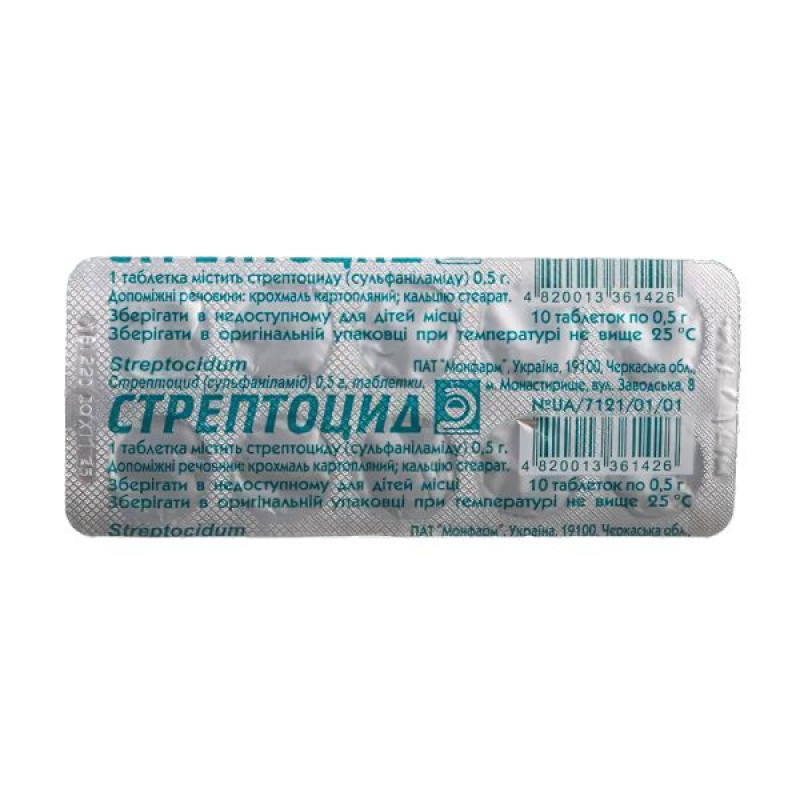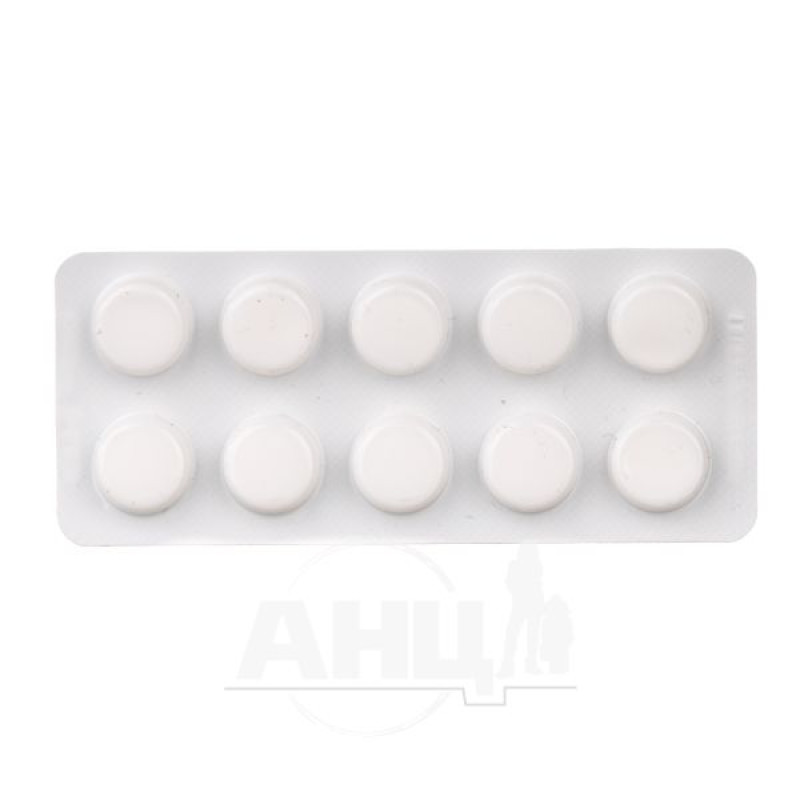Streptocide tablets 0.5 g blister No. 10

Instructions Streptocide tablets 0.5 g blister No. 10
Composition
active ingredient: streptocide;
1 tablet contains streptocide (sulfanilamide) 500 mg (0.5 g);
excipients: potato starch, calcium stearate.
Dosage form
Pills.
Main physicochemical properties: white tablets with a flat surface, beveled edges and a score.
Pharmacotherapeutic group
Antimicrobials for systemic use. Sulfonamides. ATX code J01E B06.
Pharmacological properties
Pharmacodynamics.
Streptocide, like other sulfonamides, disrupts the formation of growth factors in microorganisms - folic, dihydrofolic acids, other compounds containing para-aminobenzoic acid in their molecule. Due to the fact that its structure is close to the structure of streptocide, the latter, as a competitive antagonist of this acid, is included in the metabolic chain of microorganisms and disrupts metabolic processes, which leads to a bacteriostatic effect. The drug belongs to short-acting sulfonamides.
Streptocide has a bacteriostatic effect on streptococci, meningococci, gonococci, Escherichia coli, pathogens of toxoplasmosis and malaria. It is significantly inferior in effectiveness to modern antibiotics. Currently, many strains of microorganisms, especially hospital ones, are resistant to streptocide.
The activity of streptocide increases in an alkaline environment.
Enterococci, Pseudomonas aeruginosa, and anaerobes are not sensitive to streptocide.
Pharmacokinetics.
When administered orally, the drug is rapidly absorbed: the maximum concentration of streptocide in the blood is observed after 1-2 hours, after 4 hours the drug is detected in the cerebrospinal fluid. A decrease in the maximum concentration in the blood by 50% is noted in less than 8 hours. About 95% of the drug is excreted by the kidneys.
Indication
Infectious-inflammatory diseases caused by microorganisms sensitive to the drug: infectious diseases of the skin and mucous membranes (wounds, ulcers, bedsores), enterocolitis, pyelitis, cystitis.
Contraindication
- Individual intolerance to sulfonamides, sulfones and other components of the drug; history of severe toxic-allergic reactions to sulfonamides;
- nephrosis, nephritis;
- Graves' disease;
- acute hepatitis;
- suppression of bone marrow hematopoiesis;
- renal and/or hepatic failure;
- decompensated chronic heart failure;
- congenital deficiency of glucose-6-phosphate dehydrogenase, porphyria;
- diseases of the hematopoietic system: anemia, leukopenia;
- hyperthyroidism;
- azotemia.
Interaction with other medicinal products and other types of interactions
When used simultaneously:
- with nonsteroidal anti-inflammatory drugs, sulfonylurea derivatives, antithrombotic agents, vitamin K antagonists - the effect of these drugs is enhanced;
- with folic acid, bactericidal antibiotics (including penicillins, cephalosporins) - the effectiveness of sulfonamides decreases;
- with bactericidal antibiotics, oral contraceptives - the effect of these drugs is reduced;
- with para-aminosalicylic acid (PASA) and barbiturates - the activity of sulfonamides increases;
- with pyrazolidone derivatives, indomethacin and salicylates - the activity and toxicity of sulfonamides increases;
- with methotrexate and difenin - the toxicity of sulfonamides increases;
- with erythromycin, lincomycin, tetracycline - antibacterial activity is mutually enhanced, the spectrum of action is expanded;
- with rifampicin, streptomycin, monomycin, kanamycin, gentamicin, oxyquinoline derivatives (nitroxoline) - the antibacterial effect of the drugs does not change;
- with nalidixic acid (Nevigramon) - sometimes antagonism is observed;
- with chloramphenicol, nitrofurans - the total effect is reduced;
- with drugs containing para-aminobenzoic acid esters (novocaine, anestezin, dicaine), the antibacterial activity of sulfonamides is inactivated.
Sulfonamides are not prescribed simultaneously with hexamethylenetetramine (urotropine), with antidiabetic drugs (sulfonylurea derivatives), with diphenin, neodicoumarin and other indirect anticoagulants.
Streptocide may enhance the effect and/or toxicity of methotrexate by displacing it from protein binding and/or weakening its metabolism.
When used simultaneously with other drugs that cause bone marrow suppression, hemolysis, hepatotoxicity, toxic effects may develop. Simultaneous use with methenamine (urotropine) is not recommended due to the increased risk of crystalluria with an acidic urine reaction.
Phenylbutazone (butadione), salicylates and indomethacin can displace sulfonamides from their binding to plasma proteins, thereby increasing their concentration in the blood. When used together with para-aminosalicylic acid and barbiturates, the activity of sulfonamides increases; with chloramphenicol - the risk of agranulocytosis increases.
Application features
During long-term treatment with the drug, it is necessary to periodically perform blood tests (biochemical and general blood tests). Prescribing the drug in insufficient doses or early discontinuation of the drug may contribute to the increase in the resistance of microorganisms to sulfonamides.
Sulfonamides should not be used to treat infections caused by group A beta-hemolytic streptococcus because they do not eradicate it and therefore cannot prevent complications such as rheumatic fever and glomerulonephritis.
The drug should be prescribed with caution to patients with chronic heart failure, liver disease and impaired renal function. In renal failure, cumulation of sulfonamide and its metabolites in the body is possible, which can lead to the development of a toxic effect.
Streptocide should be prescribed with caution to patients with severe allergic diseases or bronchial asthma, with diseases of the blood system. If signs of a hypersensitivity reaction appear, the drug should be discontinued.
Sulfonamides, including streptocide, should be used with caution in patients with diabetes mellitus, as sulfonamides can affect blood sugar levels. High doses of sulfonamides have a hypoglycemic effect.
Since sulfonamides are bacteriostatic, not bactericidal drugs, a full course of therapy is necessary to prevent recurrence of infection and the development of resistant forms of microorganisms.
Given the similarity of chemical structure, sulfonamides should not be used in people with hypersensitivity to furosemide, thiazide diuretics, carbonic anhydrase inhibitors, and sulfonylurea derivatives.
Patients need to consume sufficient fluids to prevent crystalluria and the development of urolithiasis.
Elderly people are at increased risk of developing severe adverse skin reactions, hematopoiesis suppression, and thrombocytopenic purpura (the latter especially when combined with thiazide diuretics).
The drug should be avoided in patients over 65 years of age due to an increased risk of severe adverse reactions.
It is recommended to avoid exposure to direct sunlight and artificial ultraviolet radiation due to the possibility of photosensitization when using sulfonamides.
During treatment, it is necessary to adhere to the dosage regimen, apply the recommended dose at intervals of 24 hours, without skipping a dose. In case of missing a dose, do not double the next dose.
If the signs of the disease do not disappear or, conversely, the state of health worsens or undesirable phenomena occur, it is necessary to suspend the use of the drug and consult a doctor regarding further use of the drug.
Use during pregnancy or breastfeeding
The drug is contraindicated for use during pregnancy or breastfeeding.
Ability to influence reaction speed when driving vehicles or other mechanisms
Until the patient's individual reaction to the drug is determined, one should refrain from driving or operating other mechanisms, considering that during treatment with Streptocide, such adverse reactions from the nervous system as dizziness, convulsions, ataxia, drowsiness, depression, and psychosis are possible.
Method of administration and doses
Take orally during or after meals, with 150–200 ml of water. Adults and children over 12 years of age are prescribed 500–1000 mg 5 times a day, a total of 3–6 g per day. Maximum dose for adults: single dose – 2 g, daily dose – 7 g.
Children aged 3 to 6 years - 250 mg 4-6 times a day, from 6 to 12 years - 250-500 mg 4-6 times a day. Maximum dose for children: 1-2.5 g.
The duration of the treatment course is determined by the doctor individually depending on the severity and course of the disease, the localization of the process, and the effectiveness of the therapy.
Children.
The drug is not used in children under 3 years of age.
Overdose
Possible increased side effects.
Overdose may cause anorexia (lack of appetite), nausea, vomiting, colic-like pain, headache, drowsiness, dizziness, fainting. With prolonged use, fever, hematuria, crystalluria, cyanosis, tachycardia, paresthesia, diarrhea, cholestasis, renal failure with anuria, toxic hepatitis, leukopenia, agranulocytosis.
Treatment. In case of overdose, it is recommended to consult a doctor. Before providing medical care, wash the stomach with a 2% solution of sodium bicarbonate and take a suspension of activated charcoal or other enterosorbents. Drinking plenty of fluids, forced diuresis, hemodialysis are indicated. Symptomatic treatment.
Adverse reactions
From the blood and lymphatic system: leukopenia, agranulocytosis, aplastic anemia, thrombocytopenia, hypoprothrombinemia, eosinophilia, hemolytic anemia in glucose-6-phosphate dehydrogenase deficiency.
Nervous system: headache, neurological reactions including aseptic meningitis, ataxia, mild intracranial hypertension, convulsions, dizziness, drowsiness/insomnia, fatigue, depression, peripheral or optic neuropathies, visual disturbances, psychosis, depressed state, paresthesia.
On the part of the respiratory system: pulmonary infiltrates, fibrosing alveolitis.
On the part of the digestive tract: thirst, dry mouth, dyspeptic phenomena, nausea, vomiting, diarrhea, anorexia, pancreatitis, pseudomembranous colitis.
On the part of the hepatobiliary system: increased activity of liver enzymes (alanine aminotransferase (ALT), aspartate aminotransferase (ACT), alkaline phosphatase), cholestatic hepatitis, hepatonecrosis, hepatomegaly, jaundice, cholestasis.
On the part of the urinary system: change in urine color (rich yellow-brown color), crystalluria with an acidic urine reaction; nephrotoxic reactions are possible: interstitial nephritis, tubular necrosis, renal failure, hematuria, shock kidney with anuria.
Skin and subcutaneous tissue disorders: skin hyperemia, skin rashes (including erythematous-squamous, papular), itching, urticaria, allergic dermatitis, photosensitivity, exfoliative dermatitis, erythema nodosum, cyanosis.
On the part of the immune system: hypersensitivity reactions, including toxic epidermal necrolysis (Lyell's syndrome), Stevens-Johnson syndrome, systemic lupus erythematosus, serum sickness syndrome, anaphylactic reactions, angioedema, rhinitis.
General disorders: drug-induced fever, pain in the right lower abdomen and lower back.
Others: difficulty breathing, periarteritis nodosa, hypothyroidism, hypoglycemia.
Expiration date
5 years.
Storage conditions
Store in the original packaging at a temperature not exceeding 25 °C.
Keep out of reach of children.
Packaging
10 tablets in strips or blisters.
10 tablets in a strip; 2 or 10 strips in a cardboard pack.
10 tablets in a blister; 2 or 10 blisters in a cardboard pack.
Vacation category
According to the recipe.
Producer
PJSC "Monpharm".
Location of the manufacturer and address of its place of business.
Ukraine, 19161, Cherkasy region, Uman district, Avramivka village, Zavodska st., 8.
There are no reviews for this product.
There are no reviews for this product, be the first to leave your review.
No questions about this product, be the first and ask your question.







